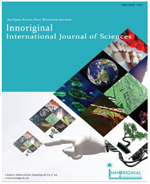PROFILE OF GROWTH AND THE Α-AMYLASE PRODUCTION FROM VARIOUS BACILLUS SPECIES
Abstract
In the present research work, three bacteria Bacillus subtilis, Bacillus licheniformis, and Lactobacillus acidophilus  were subjected to study their growth profile and alpha amylase production from them. Nutrient agar and nutrient broth medium were used for their growth. In the nutrient broth, it was found that these bacteria were able to produce α-amylase. Production of α-amylase from these bacteria were studied through Iodine assay and DNSA. It was investigated that DNSA technique is better than Iodine assay.Key words: Bacillus subtilis, Bacillus licheniformis, Lactobacillus acidophilus, and the alpha amylase.References
AjitaSundarram,ThirupathihalliPandurangappa Krishna Murthy .(2014). α-Amylase Production and Applications: A Review.Journal of Applied & Environmental Microbiology, 2 (4), pp 166-175
Brock &Medigan (2003).Enzyme production by microorganism. Biology of microorganism pp 377
Bernfeld (1955). Amylases α- and β-methods. Enzymology 1:pp.149-158
Crabb, W.D., Mitchinson, C., 1997. Enzymes involved in the processing of starch to sugars. TIBTECH., 15, 49-352.
Collins &Lyne (1996). Laboratory technique series microbial method. Butterworth Publication pp 100
GoyalNidhi, J.K. Gupta, & S.K. Soni. (2005).A novel raw starch digesting thermostable α-amylase from Bacillus sp. I-3 and its use in the direct hydrolysis of raw potato starch. Enzyme & Microbial Technology. 37:723-734
Harwood CR (1989) Introduction to the Biotechnology of Bacillus. In: Harwood CR (eds) Biotechnology handbooks, Bacillus, vol 2. Plenum, New York, pp 1–4.
Hamilton Lynn M., Catherine T. Kelly, and William M. Fogarty. (1999). Production and properties of the raw starch-digesting α-amylase of Bacillus sp.IMD 435. Process Biochemistry 35:27-31
Huang Hanjing, Darin Ridgway, TingyueGu,n& Murray Moo-Young. (2003). A segregated model for heterologous amylase production by Bacillus subtilis. Enzyme & Microbial Technology, 32, 407-413
Kobayashi Y, Kawamura F (1992) Molecular Cloning. In: Doi RH, Mcgloughlin M (eds) Biology Bacilli Applications To Industry, Butterworth-Heinemann, USA, pp 123–188.
Konsula Z, and M.Liakopoulou-Kyriakides. (2004). Hydrolysis of starches by the action of α-amylase from Bacillus subtilis. Process biochemistry. 39:1745-1749
Madigan MT (1997) Genetic engineering and biotechnology. In: Madigan MT, Martinko JM, Parker J (eds) Brock Biology of microorganisms, 8th edn. Prentice Hall, New Jersey.
Shrivastava R.A.K. and J.N. Baruah (July,1986). Culture conditions for production of Thermostable Amylase by Bacillus stearothermophilus. Applied and Environmental Microbiology. 52:1, 179-184
Schallmey, M., A. Singh, and O. P. Ward. 2004. Developments in the use of Bacillus species for industrial production. Can. J. Microbiol. 50:1-17.
Stanier RY, Adelberg EA & Ingraham JL (1985) Microbial growth. In: General Microbiology. MacMillan Pub. Ltd. Houndmill, Basingstoke, Hampshire. pp 275-279.
V.Ishwaran- IARI Delhi. A treatise on media & method used in Bacteriological Technique. Today & Tomorrow’s printers & publishers, New Delhi; pp 165
Wrint Rick and Ahns Peter Stegbauer.(1947). Measurement of reducing groups.In Methods of Enzymatic analysis. 2:885
Windish, W. W., &Mhatre, N. S. (1965). Microbial amylases. In W. U. Wayne (Ed.). Advances in applied microbiology (Vol. 7, pp. 273–304). New York: Academic Press.


